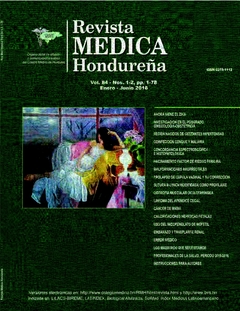Spectroscopic and histopathologic moderate concordance in patients with non-traumatic brain injuries, Hospital Escuela Universitario, 2012 - 2015
Keywords:
Cerebrum, Brain neoplasm, Magnetic resonance spectroscopy, PathologyAbstract
Background: The comparison between spectroscopy and histopathology is based on the variation of the metabolites found in the brain lesions. In Honduras there is not data about diagnostic correlation between these methods. Objective: To determine diagnostic concordance between magnetic resonance spectroscopy and histopathology in patients with non-traumatic brain injuries, Adult Neurosurgery Ward, Hospital Escuela Universitario, Tegucigalpa 2012-2015. Methodology: Evaluation of concordance between diagnostic tests in patients older than 18 years old, with non-traumatic brain injury. Socio demographic, antecedents, clinical presentation and diagnostic results, were registered. Data was processed in SPSS program version 22. Concordance was established by estimating Kappa index. Results: From 150 cases, we evaluated 42 patients with inclusion criteria; 57.1% (24) males, mean age 44.8 years (18-79), 17 (40.5%) from Francisco Morazán. At hospitalization, patients presented intracranial hypertension 38.1% (16), hemiparesis 33.3% (14), peripheral facial palsy 4.8% (2). The metabolites Choline and N-Acetyl Aspartate presented elevation 76.2% (32) and decreased 71.4% (30), respectively. Low-grade astrocytoma 9 (21.4%) and high-grade 8 (19.0%) were the most common spectroscopic diagnosis. Low-grade and high-grade astrocytoma, 10 (23.8%) each, were the most frequent histopathological diagnosis. Kappa index 0.467 (moderate) was estimated. Discussion: The moderate concordance between spectroscopic and histopathologic diagnosis suggests that the combination of both improves the accuracy of diagnosis but not the differentiation among types of brain injury.
Downloads
187





